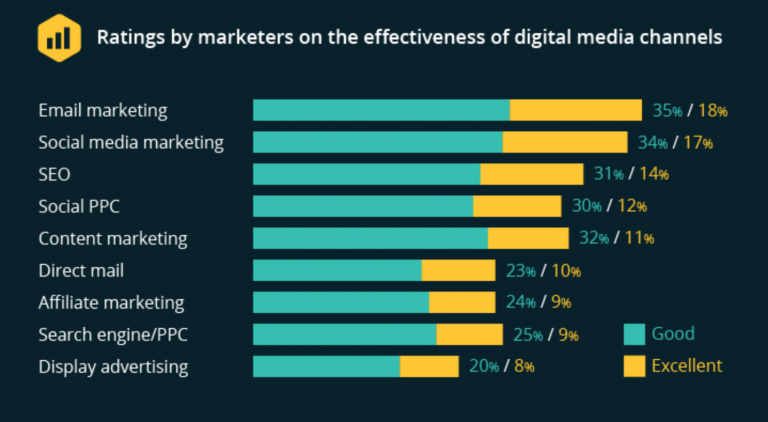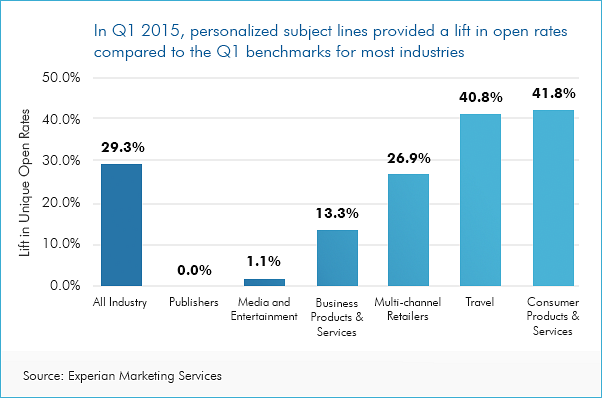

Email marketing is still one of the most effective channels for businesses with subject lines being the single most important piece of copy in your entire email.


Yet people too frequently spend most of their attention on the body of the message, throwing together the subject at the last minute. But, without a good subject line, the reader never opens the email, and your prospects won’t see a single word of the message you worked so hard to write.


When trying to improve their subject lines, most people will look for email best practices and analyze messages from their competitors.
But there’s also another less-obvious source that can provide powerful, time-tested guidance for writing better subject lines: email’s predecessor — direct mail.
In the book Open Me Now, legendary copywriter Herschell Gordon Lewis explains the “cardinal rule” of direct mail:
We can adapt this to create our own “cardinal rule” for today’s email subject lines:
That’s the one and only goal.
Why?
Because with email subject lines, space is precious. You only get a few dozen characters to get your point across. The fastest way to make readers ignore your email is to write a confusing subject line that tries to do too much.
But even if your entire message is succinct enough to fit into your subject line, you still don’t want to give away your whole pitch. If you do that, the reader will already have all the information they need to make a decision, and there would be no reason for them to click to open the email!
So, how to increase email open rates?
With our cardinal rule of email subjects in mind, here are four subject line psychology hacks to optimize your subject lines for a better open rate:
1. Tap Into the 6 Principal Marketing Motivators.
Successful direct mailers have collected decades of A/B test data based on segmenting consumers and their purchase history, as well as demographic, behavioral, and psychographic characteristics.
Through their tests, direct mailers found that there are a small group of emotions that are the most effective at getting readers to act.
In his book, Lewis outlines six “marketing motivators” that increase the response rate for direct mail, which we can also use in our subject lines. They are:
- Fear
- Exclusivity
- Greed
- Guilt
- Need for approval
- Anger
If you can tap into these emotions with your subject line, you’re more likely to trigger a response from the reader and get better email open rates.
To get even more tactical, here’s a list of powerful words and phrases that advertising legend David Ogilvy recommends in his autobiography, Confessions of an Advertising Man, to increase response rates:
| How to | Suddenly | Now | Announcing | Introducing | It’s here |
| Just arrived | Important development | Improvement | Amazing | Sensational | Remarkable |
| Revolutionary | Startling | Miracle | Magic | Offer | Quick |
| Easy | Wanted | Challenge | Advice to | The truth about | Compare |
| Bargain | Hurry | Last chance |
Putting it all together, here are six sample subject lines illustrating each of the marketing motivators. Each one also contains one of Ogilvy’s power phrases, identified in bold below:
- Fear: Breaking! Economists announce coming crash. Are you ready?
- Exclusivity: Only 100 widgets left — last chance to order
- Greed: Millionaire money secrets suddenly revealed
- Guilt: Insurance advice to parents — your children may be at risk
- Need for approval: 10 remarkable recipes all your friends will ask for
- Anger: Startling health secrets your doctor is keeping from you
2. Ask a Provocative Question.
Using questions in your email subject lines is another great way to get your audience to engage with your message and increase email open rates. Instead of forcing your ideas on an unprepared reader with a definitive statement, using a question invites the reader to participate and provide the answer.
This give-and-take makes the reader a partner in the sales cycle, instead of an object. If the reader has a feeling of agency and control over the process, it makes them more likely to trust you and continue reading the rest of your pitch.
Consider the following two example subject lines for the same language learning product:
- Learn to speak Japanese fluently in 30 days!
- Is it possible to fluently speak Japanese in 30 days?
Most people would be skeptical of the first subject line. It’s too forceful and pushy, and they would distrust a promise that large — assuming it’s too good to be true, so it must be a scam.
The second subject line includes the same promise, but wrapped in a question. Instead of telling the audience they can learn a new language (Japanese in this case) in 30 days, we’re just asking them if they think it’s possible. In this case, even if the person thinks to themselves “no, it’s not,” they’re curious to see if maybe they’re wrong. Because you haven’t tried to force your message on the reader, they are now open to hearing more.


If you use this technique, the first part of the email body should directly address the question you posed in the subject line.
For the language example above, you would start by acknowledging the reader’s skepticism about learning Japanese in 30 days, then turn it into an opportunity to gently convince them that they might be wrong. You could say something like this:
“If you’re like most people, the idea of learning a complex language like Japanese in 30 days seems outrageous. Even if it were possible, it would probably require so much sacrifice and pain that the results wouldn’t be worth it.
However, if you can put aside your doubts for a moment, we want you to know about a revolutionary approach to language learning that can really help you speak a new language fluently in just one month.”
3. Avoid Title Case.
Consumers get so many unsolicited marketing and spam messages in their inbox, one of the main obstacles preventing your emails from being opened is the reader’s general lack of trust.


Your job as a business owner or marketer is to find ways around this skepticism so that your subject line catches the reader’s attention in a way that makes them receptive to hearing more about your message.
One way to do this is phrasing your subject as a question like we discussed in the last section.
Another thing you can do is stop capitalizing the first letter of every word in your subject line, and instead, write it as you would a normal sentence.
For example:
- Don’t: Breaking! Economists Announce Coming Crash. Are You Ready?
- Do: Breaking! Economists announce coming crash. Are you ready?
The difference is subtle, but readers are so skeptical today that even the smallest cues will cause them to reject an email as spam.
Capitalizing the first letter in every word of your subject line is almost a dead giveaway to the reader that it’s a marketing message that should be ignored — and this lesson even predates email. In earlier decades, successful direct mailers would avoid using first-letter caps on their envelopes to ensure more of them were opened.
Since most businesses are overly formal and will write in first-letter caps, simply avoiding this syntax and writing your subjects as a proper sentence (which is still totally professional) can help you sidestep some of your reader’s distrust and increase your open rates.
4. Take Advantage of Personalization.
In the seminal book How to Win Friends and Influence People, which has sold over 30 million copies and was ranked #19 by Time Magazine on the list of 100 most influential books, Dale Carnegie says:
This lesson is nearly a century old, but data has proven it’s a timeless adage that is true across generations. A recent study showed that personalizing an email subject line using someone’s name can, on average (depending on industry), increase the open rate by nearly 30%.


Whenever possible, find a way to include the prospect’s name in the subject line.
Here’s a sample subject that uses this technique, as well as the other three we covered earlier in the post:
- Economists announce coming crash. Are you ready, [Name]?
This subject uses fear as the marketing motivator and one Ogilvy’s power words from the first section. It uses a question to increase curiosity as we suggested. It doesn’t use all caps like we said to avoid in section number three, and it adds the person’s name like we advised in section number four.
We deleted “Breaking!” here because when we added the person’s name on the end of the subject line it became longer than 60 characters, which is a maximum length that some email providers recommend as a guideline (though depending on the device being used to open the email, it could be much shorter). Any longer and most email platforms begin chopping off the end of your message and replacing it with a “…”.
Some platforms, especially on mobile, start cutting things off even sooner. So if you can, test your subject lines on various platforms and devices to make sure your complete message comes across.
The Missing Piece to The Cardinal Rule of Email Subjects.
Because we adapted our cardinal rule of email subjects from direct mail, it makes one assumption: that you’ve segmented your customers or qualified your list in advance.
In direct mail, the cost of sending a package to a prospect forced marketers to be selective about who got their messages. Efficiency was the key to profitability, so they had to be ruthless about cutting down the number of letters they sent that didn’t generate a response.
This ensured that they only sent mail to prospects that they wanted to have as customers — to do otherwise was to waste money and drag down the bottom line.
But because email costs virtually nothing to send, online marketers often feel that the more people they can message, the better. (Taken to the extreme, you get spammers).
The last thing you want to do is optimize your email subject line and increase your email open rates, only to find that your copy actually caused one of the following two situations:
1. Only low-quality contacts are opening your emails
So we need to tweak our cardinal rule of email subjects to reflect the importance of targeting. That way, when you apply the direction in this post to optimize your subject lines, it aligns with your ultimate goal of generating more business.
2. More opens with less engagement
The purpose of what we taught you here today was how to appeal to people’s emotions to get your email subject to stand out and entice people on your list to click on your message. However, it should be noted that it’s equally important for your email message to align with your email subject as your end goal should be to get people to take a specific action.
A clickbait email subject that doesn’t deliver on its promise will not only get subscribers to send your message to the trash, but it may also prevent them from opening subsequent emails.


This is an example of a clickbait subject that doesn’t live up to the hype. The subject line mentions that the invitation is an exclusive offer/discount. However, upon opening the message, it was a typical page where anyone could get 40% off as part of a sale. The message wasn’t even personalized, so how exclusive could the invitation be?
So with that said, our ultimate rule should be as follows:
So now you know how to write good subject lines for emails. Follow this rule, using the 4 subject line psychology hacks from this post, and watch the performance of your email marketing climb
A 10-plus year veteran of the digital marketing industry, Anthony Capetola has built and managed successful SEM and Social PPC campaigns for hundreds of small to large-sized businesses in various industry verticals including national franchises and eCommerce. As the current Marketing Manager for Sales & Orders, which provides management software for Google Shopping, Anthony manages the entirety of paid search and inbound marketing efforts.
 Deutsch
Deutsch





















Comments
I love the ‘Avoid Title Case’ tip.
Drift chat is even going further. You’ll notice that they don’t use a single capital letter in their subject line. Now I know why 🙂
Glad you like the tip Greg! Yes, it’s always interesting to look at what different companies are doing in the inbox to stand out. Sometimes it can be surprising what draws your attention.
Thanks for this ! Very interesting…I am going to try this right now 😉
I’d try your advices to start my email marketing campaign,
thanks for crafting this advice list
These days I am spending a lot of my time to learn email marketing hacks and this email landed in my inbox at the right time. Last week I finished reading two books, Cashvertiging and Predictably Irrational. Both of them taught the same principles which you mentioned in this article. I was making one mistake (capitalizing the first letter) while sending my emails. After reading this article, I am not going to use them in my titles and going to observe the open rate.
Thanks. 🙂
Great tips!
I really learnt a lot. Can’t wait to try it out on my new site.
I could relate because I discovered I should just write emails the way I’ll want to be written to!
Thanks lots Anthony. You’re truly a veteran in marketing!
How can we insert the name in the subject line?
Hello Camilo! As a Sendinblue user you can personalize the subject line by adding the placeholder {{ contact.FIRSTNAME }}. For full details on using contact attributes for email personalization please read this article from our Help Center. Hope this helps! Best, Emma
Good article – definitely will try to incorporate some of the tips. Interested to know if Sendinblue supports an email that auto-plays a video clip like in this article?
Hi Gary. Glad you enjoyed the article! Sendinblue’s messaging software does not currently support video files. For some alternative ways to include video in your email please read this article. Hope that helps! Best, Emma
Ready to find your marketing zen?
Take the stress out of your work day with a solution that’s built for you!
Get started free